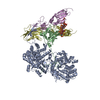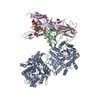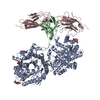[English] 日本語
 Yorodumi
Yorodumi- EMDB-34075: Cryo-EM Structure of FGF23-FGFR1c-aKlotho-HS Quaternary Complex -
+ Open data
Open data
- Basic information
Basic information
| Entry |  | |||||||||
|---|---|---|---|---|---|---|---|---|---|---|
| Title | Cryo-EM Structure of FGF23-FGFR1c-aKlotho-HS Quaternary Complex | |||||||||
 Map data Map data | ||||||||||
 Sample Sample |
| |||||||||
 Keywords Keywords | FGF hormones /  FGF Receptor / Klotho Co-Receptor / Heparan Sulfate Glycosaminoglycans / FGF Receptor / Klotho Co-Receptor / Heparan Sulfate Glycosaminoglycans /  SIGNALING PROTEIN SIGNALING PROTEIN | |||||||||
| Function / homology |  Function and homology information Function and homology informationtype 1 fibroblast growth factor receptor binding / FGFRL1 modulation of FGFR1 signaling / norepinephrine biosynthetic process / positive regulation of vitamin D 24-hydroxylase activity /  beta-glucuronidase / beta-glucuronidase /  beta-glucuronidase activity / negative regulation of hormone secretion / FGFR1c and Klotho ligand binding and activation / regulation of phosphate transport / positive regulation of MAPKKK cascade by fibroblast growth factor receptor signaling pathway ...type 1 fibroblast growth factor receptor binding / FGFRL1 modulation of FGFR1 signaling / norepinephrine biosynthetic process / positive regulation of vitamin D 24-hydroxylase activity / beta-glucuronidase activity / negative regulation of hormone secretion / FGFR1c and Klotho ligand binding and activation / regulation of phosphate transport / positive regulation of MAPKKK cascade by fibroblast growth factor receptor signaling pathway ...type 1 fibroblast growth factor receptor binding / FGFRL1 modulation of FGFR1 signaling / norepinephrine biosynthetic process / positive regulation of vitamin D 24-hydroxylase activity /  beta-glucuronidase / beta-glucuronidase /  beta-glucuronidase activity / negative regulation of hormone secretion / FGFR1c and Klotho ligand binding and activation / regulation of phosphate transport / positive regulation of MAPKKK cascade by fibroblast growth factor receptor signaling pathway / intracellular phosphate ion homeostasis / vitamin D catabolic process / response to sodium phosphate / phosphate ion homeostasis / negative regulation of bone mineralization / Signaling by activated point mutants of FGFR3 / FGFR3c ligand binding and activation / Phospholipase C-mediated cascade; FGFR3 / beta-glucuronidase activity / negative regulation of hormone secretion / FGFR1c and Klotho ligand binding and activation / regulation of phosphate transport / positive regulation of MAPKKK cascade by fibroblast growth factor receptor signaling pathway / intracellular phosphate ion homeostasis / vitamin D catabolic process / response to sodium phosphate / phosphate ion homeostasis / negative regulation of bone mineralization / Signaling by activated point mutants of FGFR3 / FGFR3c ligand binding and activation / Phospholipase C-mediated cascade; FGFR3 /  fibroblast growth factor receptor binding / cellular response to vitamin D / FGFR2c ligand binding and activation / Activated point mutants of FGFR2 / fibroblast growth factor receptor binding / cellular response to vitamin D / FGFR2c ligand binding and activation / Activated point mutants of FGFR2 /  vitamin D binding / Phospholipase C-mediated cascade; FGFR2 / FGFR4 ligand binding and activation / energy reserve metabolic process / Phospholipase C-mediated cascade; FGFR4 / Signaling by activated point mutants of FGFR1 / FGFR1c ligand binding and activation / Downstream signaling of activated FGFR1 / Phospholipase C-mediated cascade: FGFR1 / response to vitamin D / cellular response to leptin stimulus / cellular response to interleukin-6 / negative regulation of systemic arterial blood pressure / response to angiotensin / cellular response to parathyroid hormone stimulus / vitamin D binding / Phospholipase C-mediated cascade; FGFR2 / FGFR4 ligand binding and activation / energy reserve metabolic process / Phospholipase C-mediated cascade; FGFR4 / Signaling by activated point mutants of FGFR1 / FGFR1c ligand binding and activation / Downstream signaling of activated FGFR1 / Phospholipase C-mediated cascade: FGFR1 / response to vitamin D / cellular response to leptin stimulus / cellular response to interleukin-6 / negative regulation of systemic arterial blood pressure / response to angiotensin / cellular response to parathyroid hormone stimulus /  beta-glucosidase activity / PI-3K cascade:FGFR3 / beta-glucosidase activity / PI-3K cascade:FGFR3 /  fibroblast growth factor binding / PI-3K cascade:FGFR2 / PI-3K cascade:FGFR4 / PI-3K cascade:FGFR1 / response to magnesium ion / PI3K Cascade / negative regulation of osteoblast differentiation / fibroblast growth factor receptor signaling pathway / calcium ion homeostasis / positive regulation of bone mineralization / SHC-mediated cascade:FGFR3 / SHC-mediated cascade:FGFR2 / SHC-mediated cascade:FGFR4 / SHC-mediated cascade:FGFR1 / FRS-mediated FGFR3 signaling / FRS-mediated FGFR2 signaling / fibroblast growth factor binding / PI-3K cascade:FGFR2 / PI-3K cascade:FGFR4 / PI-3K cascade:FGFR1 / response to magnesium ion / PI3K Cascade / negative regulation of osteoblast differentiation / fibroblast growth factor receptor signaling pathway / calcium ion homeostasis / positive regulation of bone mineralization / SHC-mediated cascade:FGFR3 / SHC-mediated cascade:FGFR2 / SHC-mediated cascade:FGFR4 / SHC-mediated cascade:FGFR1 / FRS-mediated FGFR3 signaling / FRS-mediated FGFR2 signaling /  regulation of cell migration / FRS-mediated FGFR4 signaling / Signaling by FGFR3 in disease / FRS-mediated FGFR1 signaling / Signaling by FGFR2 in disease / ERK1 and ERK2 cascade / Signaling by FGFR1 in disease / response to activity / determination of adult lifespan / Negative regulation of FGFR3 signaling / Negative regulation of FGFR2 signaling / Negative regulation of FGFR4 signaling / Negative regulation of FGFR1 signaling / animal organ morphogenesis / regulation of cell migration / FRS-mediated FGFR4 signaling / Signaling by FGFR3 in disease / FRS-mediated FGFR1 signaling / Signaling by FGFR2 in disease / ERK1 and ERK2 cascade / Signaling by FGFR1 in disease / response to activity / determination of adult lifespan / Negative regulation of FGFR3 signaling / Negative regulation of FGFR2 signaling / Negative regulation of FGFR4 signaling / Negative regulation of FGFR1 signaling / animal organ morphogenesis /  Post-translational protein phosphorylation / Post-translational protein phosphorylation /  growth factor activity / growth factor activity /  hormone activity / hormone activity /  receptor protein-tyrosine kinase / Golgi lumen / Constitutive Signaling by Aberrant PI3K in Cancer / Regulation of Insulin-like Growth Factor (IGF) transport and uptake by Insulin-like Growth Factor Binding Proteins (IGFBPs) / PIP3 activates AKT signaling / PI5P, PP2A and IER3 Regulate PI3K/AKT Signaling / RAF/MAP kinase cascade / carbohydrate metabolic process / positive regulation of ERK1 and ERK2 cascade / receptor protein-tyrosine kinase / Golgi lumen / Constitutive Signaling by Aberrant PI3K in Cancer / Regulation of Insulin-like Growth Factor (IGF) transport and uptake by Insulin-like Growth Factor Binding Proteins (IGFBPs) / PIP3 activates AKT signaling / PI5P, PP2A and IER3 Regulate PI3K/AKT Signaling / RAF/MAP kinase cascade / carbohydrate metabolic process / positive regulation of ERK1 and ERK2 cascade /  cell differentiation / apical plasma membrane / positive regulation of protein phosphorylation / cell differentiation / apical plasma membrane / positive regulation of protein phosphorylation /  endoplasmic reticulum lumen / positive regulation of cell population proliferation / positive regulation of gene expression / positive regulation of DNA-templated transcription / endoplasmic reticulum lumen / positive regulation of cell population proliferation / positive regulation of gene expression / positive regulation of DNA-templated transcription /  extracellular space / extracellular exosome / extracellular region / extracellular space / extracellular exosome / extracellular region /  membrane / membrane /  plasma membrane / plasma membrane /  cytoplasm cytoplasmSimilarity search - Function | |||||||||
| Biological species |   Homo sapiens (human) Homo sapiens (human) | |||||||||
| Method |  single particle reconstruction / single particle reconstruction /  cryo EM / Resolution: 2.74 Å cryo EM / Resolution: 2.74 Å | |||||||||
 Authors Authors | Mohammadi M / Chen L | |||||||||
| Funding support |  China, 1 items China, 1 items
| |||||||||
 Citation Citation |  Journal: Nature / Year: 2023 Journal: Nature / Year: 2023Title: Structural basis for FGF hormone signalling. Authors: Lingfeng Chen / Lili Fu / Jingchuan Sun / Zhiqiang Huang / Mingzhen Fang / Allen Zinkle / Xin Liu / Junliang Lu / Zixiang Pan / Yang Wang / Guang Liang / Xiaokun Li / Gaozhi Chen / Moosa Mohammadi /   Abstract: α/βKlotho coreceptors simultaneously engage fibroblast growth factor (FGF) hormones (FGF19, FGF21 and FGF23) and their cognate cell-surface FGF receptors (FGFR1-4) thereby stabilizing the endocrine ...α/βKlotho coreceptors simultaneously engage fibroblast growth factor (FGF) hormones (FGF19, FGF21 and FGF23) and their cognate cell-surface FGF receptors (FGFR1-4) thereby stabilizing the endocrine FGF-FGFR complex. However, these hormones still require heparan sulfate (HS) proteoglycan as an additional coreceptor to induce FGFR dimerization/activation and hence elicit their essential metabolic activities. To reveal the molecular mechanism underpinning the coreceptor role of HS, we solved cryo-electron microscopy structures of three distinct 1:2:1:1 FGF23-FGFR-αKlotho-HS quaternary complexes featuring the 'c' splice isoforms of FGFR1 (FGFR1c), FGFR3 (FGFR3c) or FGFR4 as the receptor component. These structures, supported by cell-based receptor complementation and heterodimerization experiments, reveal that a single HS chain enables FGF23 and its primary FGFR within a 1:1:1 FGF23-FGFR-αKlotho ternary complex to jointly recruit a lone secondary FGFR molecule leading to asymmetric receptor dimerization and activation. However, αKlotho does not directly participate in recruiting the secondary receptor/dimerization. We also show that the asymmetric mode of receptor dimerization is applicable to paracrine FGFs that signal solely in an HS-dependent fashion. Our structural and biochemical data overturn the current symmetric FGFR dimerization paradigm and provide blueprints for rational discovery of modulators of FGF signalling as therapeutics for human metabolic diseases and cancer. | |||||||||
| History |
|
- Structure visualization
Structure visualization
| Supplemental images |
|---|
- Downloads & links
Downloads & links
-EMDB archive
| Map data |  emd_34075.map.gz emd_34075.map.gz | 59.9 MB |  EMDB map data format EMDB map data format | |
|---|---|---|---|---|
| Header (meta data) |  emd-34075-v30.xml emd-34075-v30.xml emd-34075.xml emd-34075.xml | 17.9 KB 17.9 KB | Display Display |  EMDB header EMDB header |
| Images |  emd_34075.png emd_34075.png | 106 KB | ||
| Masks |  emd_34075_msk_1.map emd_34075_msk_1.map | 64 MB |  Mask map Mask map | |
| Others |  emd_34075_half_map_1.map.gz emd_34075_half_map_1.map.gz emd_34075_half_map_2.map.gz emd_34075_half_map_2.map.gz | 59.5 MB 59.5 MB | ||
| Archive directory |  http://ftp.pdbj.org/pub/emdb/structures/EMD-34075 http://ftp.pdbj.org/pub/emdb/structures/EMD-34075 ftp://ftp.pdbj.org/pub/emdb/structures/EMD-34075 ftp://ftp.pdbj.org/pub/emdb/structures/EMD-34075 | HTTPS FTP |
-Related structure data
| Related structure data |  7yshMC  7ysuC  7yswC M: atomic model generated by this map C: citing same article ( |
|---|---|
| Similar structure data | Similarity search - Function & homology  F&H Search F&H Search |
- Links
Links
| EMDB pages |  EMDB (EBI/PDBe) / EMDB (EBI/PDBe) /  EMDataResource EMDataResource |
|---|---|
| Related items in Molecule of the Month |
- Map
Map
| File |  Download / File: emd_34075.map.gz / Format: CCP4 / Size: 64 MB / Type: IMAGE STORED AS FLOATING POINT NUMBER (4 BYTES) Download / File: emd_34075.map.gz / Format: CCP4 / Size: 64 MB / Type: IMAGE STORED AS FLOATING POINT NUMBER (4 BYTES) | ||||||||||||||||||||
|---|---|---|---|---|---|---|---|---|---|---|---|---|---|---|---|---|---|---|---|---|---|
| Voxel size | X=Y=Z: 1.096 Å | ||||||||||||||||||||
| Density |
| ||||||||||||||||||||
| Symmetry | Space group: 1 | ||||||||||||||||||||
| Details | EMDB XML:
|
-Supplemental data
-Mask #1
| File |  emd_34075_msk_1.map emd_34075_msk_1.map | ||||||||||||
|---|---|---|---|---|---|---|---|---|---|---|---|---|---|
| Projections & Slices |
| ||||||||||||
| Density Histograms |
-Half map: #1
| File | emd_34075_half_map_1.map | ||||||||||||
|---|---|---|---|---|---|---|---|---|---|---|---|---|---|
| Projections & Slices |
| ||||||||||||
| Density Histograms |
-Half map: #2
| File | emd_34075_half_map_2.map | ||||||||||||
|---|---|---|---|---|---|---|---|---|---|---|---|---|---|
| Projections & Slices |
| ||||||||||||
| Density Histograms |
- Sample components
Sample components
-Entire : 1:2:1:1 FGF23-FGFR1c-aKlotho-HS Quaternary Complex
| Entire | Name: 1:2:1:1 FGF23-FGFR1c-aKlotho-HS Quaternary Complex |
|---|---|
| Components |
|
-Supramolecule #1: 1:2:1:1 FGF23-FGFR1c-aKlotho-HS Quaternary Complex
| Supramolecule | Name: 1:2:1:1 FGF23-FGFR1c-aKlotho-HS Quaternary Complex / type: complex / ID: 1 / Parent: 0 / Macromolecule list: #1-#3 |
|---|---|
| Source (natural) | Organism:   Homo sapiens (human) Homo sapiens (human) |
-Macromolecule #1: Klotho
| Macromolecule | Name: Klotho / type: protein_or_peptide / ID: 1 / Details: Klotho co-receptor / Number of copies: 1 / Enantiomer: LEVO / EC number:  beta-glucuronidase beta-glucuronidase |
|---|---|
| Source (natural) | Organism:   Homo sapiens (human) Homo sapiens (human) |
| Molecular weight | Theoretical: 109.164797 KDa |
| Recombinant expression | Organism:   Homo sapiens (human) Homo sapiens (human) |
| Sequence | String: EPGDGAQTWA RFSRPPAPEA AGLFQGTFPD GFLWAVGSAA YQTEGGWQQH GKGASIWDTF THHPLAPPGD SRNASLPLGA PSPLQPATG DVASDSYNNV FRDTEALREL GVTHYRFSIS WARVLPNGSA GVPNREGLRY YRRLLERLRE LGVQPVVTLY H WDLPQRLQ ...String: EPGDGAQTWA RFSRPPAPEA AGLFQGTFPD GFLWAVGSAA YQTEGGWQQH GKGASIWDTF THHPLAPPGD SRNASLPLGA PSPLQPATG DVASDSYNNV FRDTEALREL GVTHYRFSIS WARVLPNGSA GVPNREGLRY YRRLLERLRE LGVQPVVTLY H WDLPQRLQ DAYGGWANRA LADHFRDYAE LCFRHFGGQV KYWITIDNPY VVAWHGYATG RLAPGIRGSP RLGYLVAHNL LL AHAKVWH LYNTSFRPTQ GGQVSIALSS HWINPRRMTD HSIKECQKSL DFVLGWFAKP VFIDGDYPES MKNNLSSILP DFT ESEKKF IKGTADFFAL CFGPTLSFQL LDPHMKFRQL ESPNLRQLLS WIDLEFNHPQ IFIVENGWFV SGTTKRDDAK YMYY LKKFI METLKAIKLD GVDVIGYTAW SLMDGFEWHR GYSIRRGLFY VDFLSQDKML LPKSSALFYQ KLIEKNGFPP LPENQ PLEG TFPCDFAWGV VDNYIQVDTT LSQFTDLNVY LWDVHHSKRL IKVDGVVTKK RKSYCVDFAA IQPQIALLQE MHVTHF RFS LDWALILPLG NQSQVNHTIL QYYRCMASEL VRVNITPVVA LWQPMAPNQG LPRLLARQGA WENPYTALAF AEYARLC FQ ELGHHVKLWI TMNEPYTRNM TYSAGHNLLK AHALAWHVYN EKFRHAQNGK ISIALQADWI EPACPFSQKD KEVAERVL E FDIGWLAEPI FGSGDYPWVM RDWLNQRNNF LLPYFTEDEK KLIQGTFDFL ALSHYTTILV DSEKEDPIKY NDYLEVQEM TDITWLNSPS QVAVVPWGLR KVLNWLKFKY GDLPMYIISN GIDDGLHAED DQLRVYYMQN YINEALKAHI LDGINLCGYF AYSFNDRTA PRFGLYRYAA DQFEPKASMK HYRKIIDSNG FPGPETLERF CPEEFTVCTE CSFFHTRKS |
-Macromolecule #2: Fibroblast growth factor 23
| Macromolecule | Name: Fibroblast growth factor 23 / type: protein_or_peptide / ID: 2 / Details: FGF23 / Number of copies: 1 / Enantiomer: LEVO |
|---|---|
| Source (natural) | Organism:   Homo sapiens (human) Homo sapiens (human) |
| Molecular weight | Theoretical: 30.367006 KDa |
| Recombinant expression | Organism:   Escherichia coli (E. coli) Escherichia coli (E. coli) |
| Sequence | String: MHHHHHHSSG LVPRGSGMKE TAAAKFERQH MDSPDLGTDD DDKAMGYPNA SPLLGSSWGG LIHLYTATAR NSYHLQIHKN GHVDGAPHQ TIYSALMIRS EDAGFVVITG VMSRRYLCMD FRGNIFGSHY FDPENCRFQH QTLENGYDVY HSPQYHFLVS L GRAKRAFL ...String: MHHHHHHSSG LVPRGSGMKE TAAAKFERQH MDSPDLGTDD DDKAMGYPNA SPLLGSSWGG LIHLYTATAR NSYHLQIHKN GHVDGAPHQ TIYSALMIRS EDAGFVVITG VMSRRYLCMD FRGNIFGSHY FDPENCRFQH QTLENGYDVY HSPQYHFLVS L GRAKRAFL PGMNPPPYSQ FLSRRNEIPL IHFNTPIPRQ HTQSAEDDSE RDPLNVLKPR ARMTPAPASC SQELPSAEDN SP MASDPLG VVRGGRVNTH AGGTGPEGCR PFAKFI |
-Macromolecule #3: Isoform 20 of Fibroblast growth factor receptor 1
| Macromolecule | Name: Isoform 20 of Fibroblast growth factor receptor 1 / type: protein_or_peptide / ID: 3 / Number of copies: 2 / Enantiomer: LEVO / EC number:  receptor protein-tyrosine kinase receptor protein-tyrosine kinase |
|---|---|
| Source (natural) | Organism:   Homo sapiens (human) Homo sapiens (human) |
| Molecular weight | Theoretical: 26.373006 KDa |
| Recombinant expression | Organism:   Homo sapiens (human) Homo sapiens (human) |
| Sequence | String: DNTKPNRMPV APYWTSPEKM EKKLHAVPAA KTVKFKCPSS GTPNPTLRWL KNGKEFKPDH RIGGYKVRYA TWSIIMDSVV PSDKGNYTC IVENEYGSIN HTYQLDVVER SPHRPILQAG LPANKTVALG SNVEFMCKVY SDPQPHIQWL KHIEVNGSKI G PDNLPYVQ ...String: DNTKPNRMPV APYWTSPEKM EKKLHAVPAA KTVKFKCPSS GTPNPTLRWL KNGKEFKPDH RIGGYKVRYA TWSIIMDSVV PSDKGNYTC IVENEYGSIN HTYQLDVVER SPHRPILQAG LPANKTVALG SNVEFMCKVY SDPQPHIQWL KHIEVNGSKI G PDNLPYVQ ILKTAGVNTT DKEMEVLHLR NVSFEDAGEY TCLAGNSIGL SHHSAWLTVL EALEERPGTK HHHHHH |
-Macromolecule #5: ZINC ION
| Macromolecule | Name: ZINC ION / type: ligand / ID: 5 / Number of copies: 1 / Formula: ZN |
|---|---|
| Molecular weight | Theoretical: 65.409 Da |
-Macromolecule #6: COPPER (II) ION
| Macromolecule | Name: COPPER (II) ION / type: ligand / ID: 6 / Number of copies: 1 / Formula: CU |
|---|---|
| Molecular weight | Theoretical: 63.546 Da |
| Chemical component information |  ChemComp-CU: |
-Experimental details
-Structure determination
| Method |  cryo EM cryo EM |
|---|---|
 Processing Processing |  single particle reconstruction single particle reconstruction |
| Aggregation state | particle |
- Sample preparation
Sample preparation
| Buffer | pH: 7.5 |
|---|---|
| Vitrification | Cryogen name: ETHANE |
- Electron microscopy
Electron microscopy
| Microscope | FEI TALOS ARCTICA |
|---|---|
| Electron beam | Acceleration voltage: 200 kV / Electron source:  FIELD EMISSION GUN FIELD EMISSION GUN |
| Electron optics | Illumination mode: FLOOD BEAM / Imaging mode: BRIGHT FIELD Bright-field microscopy / Nominal defocus max: 2.2 µm / Nominal defocus min: 0.7000000000000001 µm Bright-field microscopy / Nominal defocus max: 2.2 µm / Nominal defocus min: 0.7000000000000001 µm |
| Image recording | Film or detector model: GATAN K3 (6k x 4k) / Average electron dose: 50.37 e/Å2 |
| Experimental equipment |  Model: Talos Arctica / Image courtesy: FEI Company |
- Image processing
Image processing
| Startup model | Type of model: PDB ENTRY PDB model - PDB ID: |
|---|---|
| Initial angle assignment | Type: NOT APPLICABLE |
| Final angle assignment | Type: NOT APPLICABLE |
| Final reconstruction | Resolution.type: BY AUTHOR / Resolution: 2.74 Å / Resolution method: FSC 0.143 CUT-OFF / Number images used: 1497967 |
 Movie
Movie Controller
Controller









 Z
Z Y
Y X
X


























